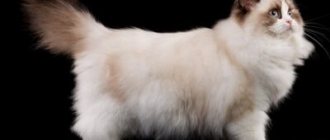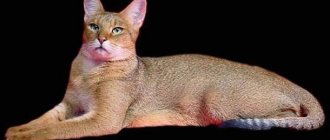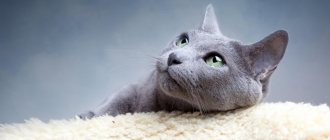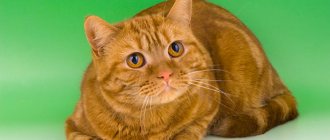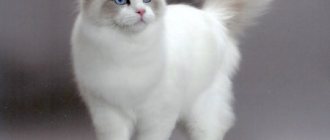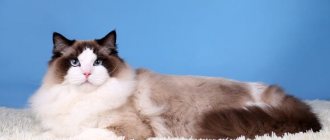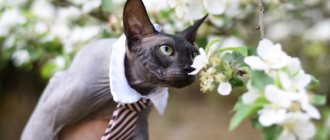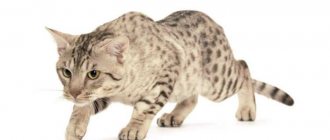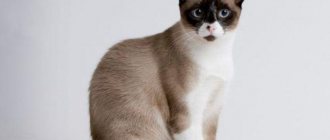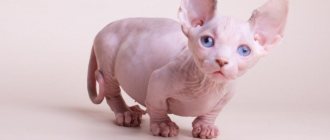Review author: “ZooVita”
Our pets are very different not only in appearance, but also in character. Some demonstrate independence, others can even be aggressive or, conversely, personify absolute love for a person. The Ragdoll cat has these qualities; She gets sincere pleasure from communicating with a person!
History of the Ragdoll breed
Ragdoll
The history of ragdoll began in the 60s of the last century. It is full of hoaxes and is associated with high-profile trials. Ragdolls owe their appearance to an enterprising lady from California, Ann Baker, who bred Persian cats, and to the cat Josephine, a long-haired beauty of a mixed breed (presumably Persian and Angora), who lived with the breeder’s neighbor. Baker bought Josephine's kittens, many of which were unusually calm in nature. She later used them to breed a new breed.
Having become famous, in her interviews the breeder claimed that Josephine was once hit by a car and ended up in a clinic where she was subjected to secret genetic experiments conducted by the CIA. Allegedly, as a result of this, the kittens that she gave birth to after the accident had special qualities: decreased muscle tone, increased pain barrier, amazing calmness. There were also incredible rumors that ragdolls were of alien origin. What was the basis of these stories - the eccentricity of Ann Baker or a publicity stunt of specialists promoting the breed - is not known exactly, but ragdolls are indeed different from all other cats in their physiology and character. According to rational experts, most likely Josephine simply had a special combination of recessive genetic traits. Subsequently, Ann Baker purposefully selected the calmest and most balanced animals for mating.
The creation of a new breed began with the offspring of Josephine, which appeared after crossing her with a Burmese cat, whose color included charcoal gray colors. Continuing the breeding work and wanting to “decorate” her pets in the other two primary colors - white and brown - Ann Baker introduced Burmese with dark brown markings to mating. Whether they were purebred is unknown, since the breeder did not document the first matings, but she loved to experiment.
Ragdoll kitten
In 1971, Anne Baker founded her own registry, called the International Ragdoll Cat Association (IRCA). Thanks to this organization, the founder of the Ragdoll breed retained control over the standard of these cats and the registered Ragdoll brand for several decades. Baker sold franchises to breeders, which meant that IRCA-member breeders had to pay licensing fees, breed Ragdolls strictly according to instructions, and pay a 10% royalty on each kitten sold. Major American and international felinological organizations, in turn, did not recognize IRCA.
In 1975, shareholders and breeders, dissatisfied with the Association's business strategy and Anne Baker's dubious claims about the origins of the Ragdoll, broke away from IRCA and founded the Ragdoll Society (RFCI). The new organization has set itself the goal of achieving official standardization of the breed and recognition of it by eminent felinological associations in the United States. The “divorce” was accompanied by a loud scandal, followed by many years of litigation.
Several decades passed before the RFCI managed to achieve championship status for the Ragdoll in all major North American cat associations, and only in 2000 the Ragdoll took part in the CFA Championship (International Association for the Breeding of New Breeds of Cats).
A sweet, flexible, wonderful cat is a ragdoll.
Thanks to their gutta-percha, ragdolls can take a variety of poses, sometimes completely unimaginable.
However, not only disputes over the rights to own the Ragdoll trademark have long been a problem for this breed. Due to the similarity of ragdolls to Burmese cats, many judges at championships constantly had problems identifying these animals: some breeders breeding Burmese cats presented their pets that did not meet the standards as ragdolls. The similarity of the Ragdoll with the Balinese cat also created problems for the breed at exhibitions and during registration in various felinological associations. Some confusion between Burmese, Balinese and Ragdolls is still the subject of debate in felinological circles today.
Despite all the ups and downs that accompanied the emergence of the Ragdoll breed, millions of people in the USA, Europe, and Australia gave their hearts to these beautiful, smart, gentle and devoted cats. They appeared in Russia about ten years ago, but, despite all their charm, they are not yet among the most popular cat breeds among Russians.
Interesting Facts
This breed has features that are unusual for other cats. There are a number of interesting facts related to ragdolls:
- They have a high pain threshold and a somewhat slow reaction.
- These cats do not have a sense of fear. They may not recognize danger to themselves, and as a result, they often get injured.
- Ragdoll kittens and cats almost do not cause allergies in humans, which is a serious advantage.
- Another difference and positive side of ragdolls is their voice. It has a soft timbre, while talkativeness is not typical for them.
Frequent questions from the owners of these cats include some questions regarding their behavior, care or nutrition. The diet must be followed according to the veterinarian's recommendations, otherwise the animal may develop health problems.
Frequently asked questions Why won't my ragdoll cat sit in my arms? This is a common myth about ragdolls. They are very tame and affectionate, they like tactile contact with the owner.
How long do ragdolls live? The average life expectancy is 12-15 years. There are individuals that live up to 20 years.
I like1I don't like
Ragdoll appearance
How lovely
Ragdolls impress not only with their beauty, but also with their size. Cats can reach a meter in length, and the largest of them weigh about 12 kg. Smaller cats - their weight is limited to 7 kg, length - up to 80 cm.
It happens that their closest relatives, Burmese cats, are mistaken for redgalls, since they are very similar in color. However, Ragdoll standards are decidedly different and strictly defined. Three classic color standards are allowed: colorpoint, mitted, bicolor. Each of them has 4 varieties: seal (dark brown), chocolate, blue, lilac.
Frame
The Ragdoll's body is long, muscular, and massive (especially in the rear). The chest is powerful, protruding forward, the neck is short, strong, the bone is wide. At the same time, muscle tone is reduced, so the animal’s body is relaxed. The abdomen may sag, usually after the age of eight.
Limbs
Medium length, strong. The hind limbs are slightly longer than the forelimbs. The feet are round, large, with tufts of hair between the toes on the pads.
Head
The head is quite massive, proportional, the chin is well developed. The muzzle with plump cheeks is pointed, the nose is of medium length.
Color point ragdoll
Ragdoll mitted color
Bi-color ragdoll
Eyes
Oval, large, wide open. Moderately widely spaced. The eyes are slightly slanted towards the bridge of the nose, which gives the cat's gaze some playfulness and a surprised look. A pronounced slant of the eyes, as well as their almond shape, are a defect in the breed. The ragdoll's eye color, depending on the lighting, is blue or bright blue.
Ears
Medium in size, wide at the base, rounded at the tips, which are sometimes decorated with tassels. The ears are slightly tilted forward.
Ragdoll face
Tail
The Ragdoll's tail is long, proportionate to the body, gradually tapering towards the tip. Densely covered with fur. A short, knobby tail is a breed defect.
Wool
Fluffy handsome man
Moderately long, thick, soft. The undercoat is minimal, so the fur does not tangle. On the forelimbs the hair is short and medium length, on the hind legs it is medium and medium-long. There is a thick collar around the neck. The length of the hair on the body increases from the shoulder blades to the tail.
By winter, the ragdoll's "fur coat" becomes even thicker. Animals living in cold climates have longer fur.
Color
Ragdoll kittens are born completely white, and only at the age of two they acquire a stable color. With age, the colors become deeper.
Colorpoint ragdolls have muzzles, ears, tails, and the lower part of their legs that are darker in color than the main, light part of the body. Noses and paw pads are in the same dark colors.
The mitted color also implies a combination of a dominant light coat color and dark fragments. At the same time, cats have white “socks” on their paws, a white stripe on their stomachs, and their chin and luxurious collar are painted the same color.
Bicolor ragdolls also have dark markings, but on the face the dark fur is combined with white, which runs between the eyes and grips the cheeks, forming a triangle. Cat paws are completely white. The nose and paw pads are pink. The “saddle” is painted dark.
Each color type may have its own colors. According to American standards, there are four of them:
Chocolate Ragdoll
- strength: base color – “light tan”, markings – dark brown;
- chocolate: dominant color – ivory, markings – milk chocolate;
- blue: main color – light gray, markings – dark gray;
- lilac: the main color is white, the markings are pinkish-gray.
The huge luxurious mustaches of ragdolls are always snow-white.
The description of the ragdoll includes the color and name of the coat. For example, force-colored cats are represented as seal colorpoint, seal mitted, and seal bicolor.
Some European felinological associations also recognize the following colors in the color of ragdolls: red, cream, tortoiseshell, tabby.
Ragdoll color
The colors of Ragdoll cats are very diverse. The photos clearly show this.
White is characteristic only of kittens; Ragdoll babies are born completely white. With age, a dark color appears, the color becomes richer and deeper. There is no red color in the Ragdoll breed.
The Bicolor color is based on a pronounced contrast of light and dark coat colors. The Latin letter V on the head, often white, dark fur on the muzzle. The back is lighter, sometimes there is spotty coloring.
Mitted color, which means glove-like: the fur on the head and tail of the animal is dark, a white stripe runs from the neck along the belly to the tail, white areas of fur adorn the hind legs, and there are white “gloves” on the front toes.
Please note ⭐⭐⭐
Oriental cat: characteristics of the breed, health, care and maintenance, rules for raising a kitten, price (150 photos)
Neva Masquerade cat: photo, description of breed and character, size, weight and color, pros and cons of the St. Petersburg cat
American shorthair cat: description of the breed, its character and care, nutrition (100 photos)
These are animals that are unique in their variety of colors; photos with different types of Ragdoll cats clearly prove this.
Ragdoll photo
Ragdoll - my gentle and affectionate giant
“The breed is a dream. There is not a single cat with such fur... delight and admiration! If you hug this beauty, you will never want to let go...” (from reviews about the breed on the Internet)
Merihelmen Hawaii Girl, Ragdoll cat.
Owner Irina Tereshina. Kennel: Ragirina*RU. Photographer: Natalya Sidorova “Paraskeva” Ragdoll is a cat of fabulous beauty with a unique character.
In terms of popularity in world rankings, this fairly new breed always occupies the first positions, but volcanoes of passions boil and burst with lava around its origin, “correctness” and genetics in the world of felinology. Today, the Ragdoll is an established breed, approved by the majority of felinological clubs, with clear standards and a categorical ban on mixing other blood during breeding work. From the 1960s to the present day, the ragdoll has been triumphantly marching across the planet, conquering cities and countries, conquering exhibitions and breaking human hearts to smithereens: it is almost impossible not to fall in love with this magnificent creature. Kittens for sale Cat nurseries Cat food Atlas of cat breeds
History of the Ragdoll breed
The first ragdolls appeared in the United States in the 1960s. Their history does not rustle the sands of the Egyptian deserts, does not rumble with the tom-toms of the ancient natives, does not shine with the whiteness of ancient bas-reliefs: everything is very simple and prosaic. American breeder Ann Baker (California) once gave birth to wonderful kittens. And they appeared from the mating of a long-haired domestic cat, Josephine (some sources say that she was an Angora breed) and a Burmese cat. Their beauty and easy-going nature shocked the owner so much that she wanted to “repeat” the experiment. Josephine gave birth to several litters, the kittens were selected for further selection by the breeder personally, and in 1965 the Ragdoll was registered as an independent breed. Ragdoll literally translates from English as “rag doll”. And this name appeared because of the funny feature of these cats, in a comfortable state, relaxing their muscles so much that they really look like plush toys, imposingly lounging on their favorite sofa, or even better, on the lap of their adored owner. In just a few years, the Ragdoll breed acquired its bright and valuable characteristics: huge size, strong and powerful physique, luxurious fluffy hair that never gets tangled, blue bottomless eyes, the ability to relax to a “doll” state and a unique character - the most beautiful thing, what is in this amazing breed.
Who is ragdoll suitable for?
A ragdoll cat can be both a family animal and a faithful companion for a lonely person. Many sources focus on its docile and affectionate character, noting that such an animal is an ideal pet for young children. At the same time, other breeders and lovers of the breed say the opposite: a giant bumpkin is unlikely to be happy with the noise, shouting and stomping - especially if the child does not grow up alone, or if he constantly has peers visiting him. Both statements are equally incorrect: a lump is a ragdoll lump, but only in moments of especially languid relaxation. Almost all ragdolls are curious, mischievous and playful, not only at the tender “kitten” age, but throughout their lives (although there are exceptions to any rule!). In addition, despite its impressive dimensions, this cat is so friendly that in a conflict situation it prefers to retreat somewhere further away rather than use its sharp claws. And the truth, as usual, always lies somewhere nearby: yes, indeed, this cat gets along well with children and with all family members, but there is one “but” when choosing this breed. It's all about its breed's anatomical features, namely that ragdolls do not know how to group themselves in a fall and land on all four paws, and they also take a very long time to develop and grow. Therefore, it is necessary to firmly explain to the child, once and for all: the pet cannot be thrown into the air, forced to jump and climb on curtains and cabinets. One awkward jump can cost your Ragdoll his health, as he risks getting quite seriously injured. Having invited a cat of this breed into your home and your heart, you will have to carefully monitor the kitten’s behavior literally from the first minutes, do not provoke it into too violent games and observe the strictest safety measures, never leave the cat alone when a window is open in the room or balcony door. If, after playing, she “flies” out the window or falls off the balcony, she will not have a chance to survive, like other cats. The conclusion follows from this: whether you live in a luxurious country mansion or in a cramped “Khrushchev” - it makes no difference. Be that as it may, the Ragdoll is intended exclusively for home keeping, and can only be walked on a harness. As a last resort, run freely in a fenced garden plot, but certainly under the supervision of the owner. Ragdoll is so positive and cheerful, and his subtle mental organization is so complex that he sees the world exclusively in bright colors. Everything new, interesting, alluring attracts him like a magnet; For such a large animal, flying up a tall tree in a matter of seconds is a piece of cake, but getting down, or, moreover, jumping, is alas... This feature is the most important and serious drawback of the Ragdoll breed. Think about it before you call the breeder and stand in line for a delightful blue-eyed baby: can you provide such a cat with a comfortable and safe existence? Now let’s try to draw a psychological portrait of the future ragdoll owner. It doesn’t matter whether it’s a man or a woman, a single person or a family, young or old, wealthy or poor. Something completely different is important. Ragdoll refutes all the axioms about cat independence, charming bitchiness, graceful and capricious mystery. He never “walks on his own” and is so in love with his owner that some people may interpret this quality as the greatest virtue, while others may interpret it as inertia, phlegmaticity, softness, and even some kind of sycophancy. A leader, a strong personality or an extravagant original is unlikely to be interested in this breed. He will not at all be pleased with the constantly purring “ball” of fluffy fur the size of half a sofa, the dog’s devoted gaze, always searching for the owner’s eye, and other calf tenderness, antics and jumps, spewed out at you in tons 24 hours a day. Such a person is more interested in taming a small “tiger”, so the cat of his dreams should have leadership qualities, a fair amount of independence, cunning and mystery. However, a ragdoll is not a porcelain figurine or a plump sofa ottoman, not a silly simpleton, and certainly not a soft fur toy for squeezing. This cat is very intelligent and sensitive, like a magic barometer, sensitive to any changes in the “weather in the house.” She experiences even a short separation from her owner extremely painfully and cannot stand conflicts and quarrels. When a cat has to be scolded for some offense, it becomes so sincerely and deeply upset that, if you do not have a heart of stone, you will immediately forget about all the “pedagogical” methods and you yourself will ask for forgiveness from your suddenly saddened pet. But if you and your ragdoll cat have found a common language and understand each other, many years of harmonious coexistence, magical discoveries, fun games, hundreds of funny and beautiful photographs, joyful moments of mutual friendship and selfless love and devotion await you.
Therefore, the Ragdoll is best suited for a sentimental, romantic, perhaps even creative person who is not against violent tenderness and often needs affection, warmth, moral support and some kind of energy “feeding”. For such an owner, a ragdoll will be not only a beloved four-legged friend, but also an excellent psychotherapist who, in a matter of seconds, will help you put all your misfortunes aside and improve your mood and well-being. Goodwill, sociability, amazing manners and extraordinary friendliness, combined with soft delicacy and unobtrusiveness, make this cat unique, very popular and in demand among lovers in all countries of the world. “This cat has a rare quality that cannot be found in anyone else like her: she prefers communication with people to any other. Ragdoll behaves like a full member of the family, and loneliness is a burden to him. If the owner or, at worst, four-legged friends are not visible nearby, the cat’s gaze fades, it becomes sad and loses weight right before our eyes,” says Jackie Vanekem, a famous felinologist and breeder from Belgium, president of the Belgian club of fans of this breed. “The owner for her is the true center of the universe. She adapts to the rhythm of his life, relentlessly follows him everywhere and often even begins to talk to him about something in an unctuous whisper, completely unexpected given her rather impressive build. Put a collar with a strap on your ragdoll, take it with you on a trip, live with him in a hotel - whatever he needs, no problem! If the owner is nearby, the cat will feel good anywhere and enjoy life.”
Features of the Ragdoll breed
This cat, along with the Maine Coon, is considered the largest breed in the world: the weight of an adult male cat can reach 10 kg, and individual representatives of this giant breed have even immortalized their names in the Guinness Book of Records as the largest and heaviest cats in the world. The body of males can reach a meter in length (from the tip of the nose to the end of the tail). A ragdoll's eyes can only be bright blue, and its mustache must certainly be white; When breeding the breed, three types of colors are allowed: color-point, bicolor, meted (a cat with “gloves” on its paws) and four colors – “seal”, blue (blue), chocolate (chocolate) and lilac (lilac). Nowadays colors such as red and tabby are also recognized. Kittens are born, as a rule, white; their coloring appears only at two years of age.
The ragdoll is characterized by a longer development: the eyes of kittens begin to open only at 10-14 days of age. However, their size is quite impressive: at the age of 6-7 months they reach 2/3 the size of an adult, while the final formation of the body and the establishment of a bright and expressive color is completed only by 3-4 years. Pussycats are significantly smaller in size than cats, but they are also characterized by a powerful, dense, muscular build. It is also surprising that with such a massive size and fluffy fur, the body proportions of Ragdolls look surprisingly harmonious and graceful, without causing any associations with brute strength and heaviness. Despite their enormous size, ragdolls are not prone to overeating and gaining excess weight. However, if the animal participates in exhibitions, the weight still has to be controlled. Most cats remain in good physical shape, large muscle mass, playfulness, activity and mobility into old age. When breeding, breeders have to choose the best of the best individuals, giving preference to two components: the correct exterior and unique character. Shy, nervous, mentally unstable cats and those prone to even the slightest aggression are unconditionally excluded from breeding. We can talk endlessly about the character of the ragdoll. In addition to all of the above, it is worth noting such a feature of the breed as the intelligence and trainability of these cats. It is easy to train a Ragdoll to use a litter tray and a scratching post; from the first hours of being in the house, he is ready to respond to his name and recognize the owner’s voice. It is believed that it can be taught some voice commands, like a dog, which is not typical for all cat breeds. Another important point: the tenderness and trustfulness of ragdolls also has the “other side of the coin.” These cats are so friendly and cheerful that they have no fear as such. In principle, a ragdoll does not try to run away from home, but if such a cat gets lost, for example, in a country house, many dangers await it: it risks getting hit by a car, falling from a great height, running into a pack of stray dogs and simply could be stolen, because her appearance is very impressive and will not leave anyone indifferent. Ragdolls love to “talk”, but they are not loud or loud. Entering into a “dialogue” with your beloved owner or bursting into a long, purring tirade is in the order of things for a ragdoll. At the same time, the voice of this cat is so melodious and pleasant that it evokes tenderness and not irritation. Ragdolls love tactile contact - that is, endless hugs, kisses, and, of course, sweet sleep in the master's bed. But, if the owner is tired, out of sorts or busy with another matter, the cat will never “butt” his knees with its forehead and, with the tirelessness of an obsessive, will storm his knees, like a climber on an impregnable peak. She is ready to wait patiently for her portion of affection for as long as convenient, but she will do everything possible to be noticed and given attention. Despite the youth of the breed, all Ragdoll owners, without exception, see centuries-old wisdom in the eyes of their cat. The Ragdoll is not impudent and independent, like most cats, but it does not fawn on people like a dog. He looks at the owner through the eyes of an equal, or more precisely, through the eyes of a friend who respects and loves you not for something, but for the fact that you simply exist in the world. According to many experts, ragdolls can easily endure trips (even long ones) in any type of transport, and do not experience fear on the road or nausea from motion sickness. However, many of them are sensitive to stress, panic on the road, and do not like unnecessary noise, loud sounds and large crowds of people around. In general, it should be said that the collective image of a ragdoll is not an axiom - as many cats as there are, so many characters, because such an interesting and intelligent cat will always be a bright individual with its own disposition and habits. Based on the structure of their coat, Ragdolls are classified as semi-longhaired cats. Their fur resembles that of an Angora cat: it is long and fluffy, moderately soft and pliable when combed. The most pleasant and delightful thing for the owner, as we said above, is that, despite the impressive length and thickness, the ragdoll’s hair does not get tangled or tangled, since ragdolls do not have a thick undercoat. Maintaining a “marathet” for such a cat is necessary, but does not pose much difficulty for the owner. In addition, Ragdolls are very clean and love to lick and clean their coat for a long time.
Ragdoll health
Ragdolls, due to their build, are susceptible to diseases of the joints of the limbs, such as hip dysplasia. There is also such an unpleasant hereditary heart disease as hypertrophic cardiomyopathy, but this diagnosis is a real “scourge” for all cats in general, so it cannot be called a specific disease of Ragdolls.
Ragdoll in modern Russia
When preparing this material, I traditionally went to storm bookstores. Imagine my surprise when, having passed dozens of points - from large hypermarkets to tiny stalls, from the House of Books to pet stores where specialized literature is sold - I discovered that a Russian-language publication about ragdolls simply does not exist in nature. At all! On the Internet, as always, there was a chaotic diversity and eclecticism. One source referred to another, sites repeated each other word for word. To separate the “wheat from the chaff” and understand where the truth is and where the unhealthy sensationalism and utter stupidity are, I had to re-read dozens of sites that were similar to each other like twin brothers. But most of all I was struck by the reviews, comments on articles and messages on forums: “Where to find a ragdoll”, “I will come for a kitten to any city, even to Ukraine”, “Save me, my cat died, and I don’t want a cat of another breed, I’ll buy a ragdoll for any money” and other cries for help. If the Ragdoll is really so popular and amazing, why is the breed in this situation in our country? Where can I find such a cat? How does a good nursery differ from a not so good one, who is to blame and what to do? To find answers to these and other questions, we turned for help to Irina Tereshina, a ragdoll breeder in St. Petersburg, the owner of the Ragirina nursery. She told us about her vision of the problem, her nursery, the current state of the breed in our country, and, of course, about her favorite, the charming cat Plushka, to whom an entire website is dedicated //www.ragdolls.ru Irina Tereshina:
- Unfortunately, in our There are very few good nurseries and breeders in the country who focus all their attention on the Ragdoll breed. Alas, the current situation is such that demand exceeds supply tens of times. I am overwhelmed, literally besieged with phone calls: when will Bun's next litter? - And really: when? Why do we have such a shortage of kittens of perhaps the most popular and beloved breed in the world? — Most likely because at the moment in Russia there really are no truly worthy nurseries and breeders. Many breed mixed breeds and do unacceptable things by crossing Ragdolls with cats of other breeds. And, alas, this situation prevails in many cities, including capital cities. For obvious reasons, I will not name “appearances” and “passwords”; I will only say that the best ragdoll nursery in our country is located in the city of Voronezh. It is very difficult for me to choose a worthy pair for my cat. Kittens from the first two litters of Plyushka quickly found good homes and live in different cities of our country, but only one girl, who went to Baku, is used for breeding. Just today her owner called me and bragged about her success at the exhibition and the success of her son. I believe that adding other blood to the breed just because of the scarcity of domestic breeding material is stupid - it’s like reinventing the wheel in the 21st century. We need enthusiasts, we need new matings, we need imported young stock from abroad, we need good advertising, and so on. — I am delighted with the photographs of your beauty! If these are just photographs, what is she like in real life?.. - Bun is a fairly ordinary representative of the breed with a typical ragdoll color. An interesting incident happened to us at one of the exhibitions. The fact is that the standard color point color of ragdolls is really chic and spectacular, but there is nothing particularly outstanding or “sensational” about it. And by chance we found ourselves next to the owner of the Neva masquerade cat. Both her favorite and my Bun turned out to be so identical that we joked for a long time: let’s play the game “find ten differences.” Naturally, breeders can see and understand the difference, but for the average person it is really difficult to distinguish one breed from another - they are equally good and surprisingly similar at first glance. And again, if we return to the topic of the development of the breed in Russia (and not only in Russia), I must say: the exterior of the Ragdoll is not so important. The main “pearl” of the breed is the cat’s character! And the task of every breeder is to preserve this sweet meekness, this devotion and kindness, this calmness and amazing tenderness, this reckless dedication and endless love, this positivity and warmth that the Ragdoll is able to give to its lucky owner. — How is your cat’s exhibition “career” developing? What titles, achievements and victories can we congratulate you (and her) on? “We were only at a few exhibitions, receiving only the necessary basic titles, without which the animal cannot be allowed for breeding. The fact is that at exhibitions my cat feels very uncomfortable, gets scared, rushes about, “squeezes”, gets angry and does not behave very well. She is a pet and cannot stand noise, fuss, crowds and large crowds of people.
Merihelmen Hawaii Girl, Ragdoll cat.
Owner Irina Tereshina. Kennel: Ragirina*RU. Photographer: Natalya Sidorova “Paraskeva” ...I must admit, Irina’s words calmed me down somewhat. Any white spot on the felinological map of our vast homeland will sooner or later be filled. The prospects of the breed, which is developing and popularizing in the rest of the civilized world at an intensive pace, opens up an uncultivated field for those who are just discovering their talent as a breeder. The future of the breed, the extensive and interesting breeding work that awaits such people, promises to bear fruit, grown on fertile soil - the soil of love for our four-legged pets. And finally, in order to inspire some of you, dear readers, to do this wonderful work, we will quote a few lines from the website of Irina Tereshina, who knows the breed first-hand and talks about it as only a person in love with her business can talk about it. “After just a couple of weeks, we realized that we had truly acquired an animal that was ideal for our home! Firstly, thanks to the characteristics of the ragdoll, Bun cannot climb or jump high, so all small objects standing and lying on tables and shelves are completely safe. And how funny it was to watch these futile attempts to climb onto a chair or onto the edge of the bathtub! Secondly, we had no problems at all with toilet training Bun - it was enough for her to show the place once, and never (!) in her entire life there was a misfire. Thirdly, it turned out that most of what is written about ragdolls in books is true, and our kitty takes such relaxed poses that it is impossible to look at it without emotion. Fourthly, it turned out to be no “brakes” at all, but a normal kitten - curious, playful and very spontaneous. Fifthly, she is very sociable and is always happy to at least sit next to her, or even better, sit in her arms or lean against a barrel if we are lying on the sofa. At the same time, she shows delicacy - she never climbs into someone’s arms herself, but asks to be picked up. There are also sixth, seventh, etc…. In general, some kind of cat angel, only without wings!” So, do you want to raise a blue-eyed angel in your home? Then welcome to the magical world of ragdolls - the affectionate and gentle giants of the cat world.
Anna Kurtz
We express our gratitude to the breeder and owner of the Ragirina nursery, Irina Tereshina, for consultations and photographs provided
Cats
Catalog of cat breeds with descriptions and photographs
Ragdoll cat breed
Ragdoll - my gentle and affectionate giant
Ragdoll character
The Ragdoll is an incredibly calm and friendly cat. She may seem lazy and phlegmatic, but this is not so; rather, the state of her soul can be described by the word “peace.” The ragdoll feels especially comfortable when its owner is nearby. For a cat, he is the center of the universe. Ragdolls literally follow their “master” on their heels, for which they have earned the nickname “dog-cat”, “puppy-cat”, “cat-dog”. These cats treat all family members with love, love to “talk” to them, while caressing them with their gentle, deep gaze. Their voice matches their character - quiet, gentle, like a whisper.
Ragdoll with a dog
Ragdolls are playful, but not overly playful. They are very peaceful, they cannot be angered even by annoying children who treat them like toys, dragging them around everywhere. In such cases, cats simply relax as much as possible, taking any poses depending on the imagination of the playful baby. Sometimes this really does not cause them any discomfort, but sometimes they simply show patience, despite the fact that such games can be dangerous for them.
Ragdolls avoid conflicts, so if they feel that a quarrel is brewing in the house, they hide, waiting for the storm to subside.
They are very friendly towards other animals in the house; even birds and fish do not awaken their predatory instincts.
Ragdoll with a child
Ragdolls are very vulnerable creatures with a delicate mental organization. They should not be shouted at because they will take it very personally and may become depressed and lose their appetite. These cats absolutely cannot stand loneliness and really miss their owners, whose long absence can even lead to the death of the animal. But they will go on a trip with their owner with pleasure: they tolerate changes in living conditions completely calmly, as long as the owner is nearby.
Ragdolls reach puberty at 3-4 years of age. But they do not violently express their instincts - they will not bother their owners with heart-rending screams and the desire to jump out the door.
Ragdolls in love are true gentlemen, they will never offend their object of passion and are ready to wait for the cat’s favor as long as they like, patiently caring for it and gently coaxing it. Many of them are real monogamous people. Kitties accept courtship favorably, although they are demanding when choosing a partner and can be capricious. They will be more lenient if the acquaintance takes place on the territory of the “gentleman”.
Description of the breed
- Large peace-loving cat. The Ragdoll is in third place in size after the Savannah and Maine Coon cat breeds
- Low muscle tone - a cat, when picked up, will go limp, like a rag doll, hence the name of the breed
- Attachment to the owner
- Not aggressive at all
- The emotional state of Ragdolls is so vulnerable that if quarrels often occur in the owner’s family, the animal can become depressed
- When aggressive from other cats, it tries to leave, and may act disgusted, shaking off its paws.
- Loneliness can make you sick.
Raising a Ragdoll
Ragdolls have high intelligence and good memory. They have a keen sense of intonation, quickly remember their name and wonderfully understand what their owner wants from them. Actually, they don’t need any special education, because delicacy is in their blood.
Buy a scratching post for your pet: red golls love to sharpen their claws, although they scratch very rarely. Train your cat to toilet from a very early age. Immediately buy a larger tray - taking into account the future size of the animal.
It will be useful to teach your cat to have fun with toys - this will help him somehow brighten up his hours of loneliness.
Most of all, ragdolls love to be in the arms, or in the hands, or anywhere, but only with the owner, whom they love more than life itself.
Ragdolls are considered the most affectionate cats in the world
Character
Highly intelligent, gentle, affectionate. They quickly master the tray and scratching post. Always fulfill the owner's requirements with maximum accuracy. They love to communicate with their owners, purring at them or meowing quietly in response. Under no circumstances should you swear at them. Assault is unacceptable. May lead to severe illness.
Care and maintenance
Ragdolls are very neat and clean. They lick their beautiful fur for a long time and carefully. It is recommended to bathe them only as a last resort, if the fur is fairly dirty with something, since this procedure causes stress in Redgalls. But you can comb them at least every day - they like it.
For everyday procedures, use a brush for Siberian cats. During molting, you need to comb the animal with greater care: first, comb the head and chest with a fine comb, then the neck, back and sides, and finally the paws and abdomen, do not touch the tail. Continue the glossing session by combing with a massage brush. Finally, run wet hands throughout your cat's fur to remove any remaining loose hair. During shedding, you can use a furminator - a special device for caring for the hair of cats and dogs.
Ragdolls have an excellent appetite, but they are not prone to obesity. These large cats need to be fed generously, especially until they are 4 years old, as they continue to grow until this age. Adult animals are fed 2-3 times a day, kittens - up to 5 times.
This cat is not averse to eating plenty: fortunately for her, she is not prone to obesity. So – bon appetit!
Premium ready-made food and natural products are suitable for feeding your purebred pet. Ragdolls benefit from boiled meat (beef, veal, rabbit, chicken) and sea fish, which should also be boiled. You can give eggs (raw and boiled) twice a week, especially to kittens. The diet must include boiled vegetables. If the cat starts to act up, replace them with meat. Porridges (semolina, oatmeal, buckwheat, wheat) are useful in small quantities. Meat and vegetable components in food should have proportions of 2:1 for adult animals and 3:1 for kittens.
Eliminate salt, spices and sugar from the cat’s diet; milk is also not recommended, but sour cream, fermented baked milk, and low-fat cottage cheese should be present in your pet’s diet. Make sure the water bowl is never empty.
Ragdolls enjoy walks. They calmly walk on a leash, and even more love to travel in the arms of their owner. Under no circumstances should these gentle, trusting creatures be left outside unattended: they are not able to fight back against other animals. And if a ragdoll gets lost, it may not find its way home. Most likely, the cat will hide somewhere and will wait patiently until the owner finds him.
Ragdoll walking on a leash
What should you pay attention to when buying a Cornish Rex?
When choosing a Cornish Rex of any age, first of all you should pay attention to the kitten’s parents, because this is what the chosen animal will look like as an adult. It is recommended to familiarize yourself in advance with defects and disqualifying defects (can be found in the breed standard), which, as a rule, are inherited
If the parents have visible defects in appearance or behavior, then you should think about whether it is worth the risk, and when buying a Cornish Rex for exhibitions or breeding, you should completely refuse to buy a kitten from such producers
It is recommended to familiarize yourself in advance with defects and disqualifying defects (can be found in the breed standard), which, as a rule, are inherited. If the parents have visible defects in appearance or behavior, then you should think about whether it is worth the risk, and when buying a Cornish Rex for exhibition or breeding, you should completely refuse to buy a kitten from such producers.
When choosing a show- and breed-class kitten, it is strongly recommended to seek the help of specialists, and never buy such kittens by hand or without looking (on the Internet).
After making sure that everything is in order with the parents’ appearance and behavior, you should familiarize yourself with their documents. If the buyer has no idea what kind of documentation cats should have and what it should look like, then this can be clarified on the official website of any cat club.
Next, you need to make sure the adequacy and health of the selected kitten. Real Cornish Rexes are very smart and affectionate, with a “knowing” look. These features are noticeable even in very young kittens. You should check with the breeder for information about childbirth, their vaccinations, injuries and other similar health issues.
To have an idea of what diseases your kitten may develop in the future, you should ask about the health of the breeders. Here we should dwell on the issue of sterilization or castration. These operations do not harm health and do not lead to developmental delays, as many believe. Most often, sterilization and castration is carried out in nurseries and only for kittens not allowed for breeding (pet class). This is done in order to maintain the “purity” of the breed line. This is a big plus for future Cornish Rex owners who want to buy a kitten “for the soul”, because they will be spared the “charms” of puberty and will save time and money that would have been spent on independently carrying out such procedures in veterinary clinics. You should also ask for advice on care, maintenance and feeding.
It is recommended to pay attention to the room in which cats are kept: how clean, spacious, comfortable it is for cats, and how many individuals are there. The breeder should be interested in who his buyers are, in what hands his pets will fall, otherwise, he should remember that the fate of the kittens does not interest him, and therefore his attitude towards cats is appropriate
Cornish Rex kittens, 7 months
Ragdoll Health and Diseases
The king is in position
Ragdoll owners should always remember the main physiological feature of their pets. Muscular relaxation does not allow these cats to group up when falling, and, unlike their counterparts, they do not always manage to land on their paws. Ragdolls simply fall over on their sides, which can lead to injury. Children, who are usually amused by the cat’s unusual clumsiness, must be told about this distinctive feature of the breed.
Although these cats prefer to sleep with their owner, the best place for them to sleep is a low, soft bed. In this case, they will not have to jump on and off the master’s bed, putting themselves in danger. They need to be accustomed to their own sleeping place from childhood. Under no circumstances should kittens be allowed to climb to heights - a fall can be fatal for the kids.
The most common disease among Ragdolls is hip dysplasia (a congenital abnormality of the joint that leads to subluxation or dislocation of the head of the femur). This defect can lead to lameness, and in some cases the animals may become immobile.
Another danger facing this breed of cats is hypertrophic cardiomyopathy (thickening of one of the walls of the heart ventricle). The disease can cause heart failure and sometimes leads to instant cardiac arrest. Animals of advanced age are at risk.
Watch your pet carefully: Ragdolls tend to hide their illnesses. It is not known exactly what this is connected with. Among the main versions are innate delicacy and an increased pain threshold. None of them have scientific confirmation.
Ragdolls, like other cats, can develop infectious diseases. To protect against them, you need to be vaccinated on time. A healthy and strong kitten is vaccinated for the first time after 3 months. If the baby is sick, the procedure should be postponed until recovery, which must be confirmed by a veterinarian.
Diseases
The congenital characteristics of the Ragdoll's muscles are such that they often cause specific diseases: the heart, hip joints. There is an increased risk of getting dislocations and subluxations.
They must be handled with care. You should definitely tell your children about this feature of animals.
How to choose a kitten
Choosing a real ragdoll is made easier by the fact that determining whether a kitten is purebred is not so difficult.
Just take the baby in your arms, and if he hangs like a rag, you have a true representative of this amazing breed in front of you. However, make sure that the kitten has a pointy face and chubby cheeks, a pointed tail, rounded ears, and bright blue eyes. The color of the kitten will not tell you anything - they are all completely white and are no different from Burmese kittens. The color scheme of ragdolls begins to appear very slowly and indistinctly, month after month, and will fully manifest itself no earlier than your pet turns 2 years old.
The physical development of Ragdoll kittens is somewhat slowed down, as is the full maturation of representatives of this cat breed. Babies' eyes finally open only two weeks after birth, and the period of feeding with mother's milk is longer than in other breeds. And although kittens begin to be sold when they are 2-3 months old, opt for a four-month strong ragdoll. By this time, mother's milk will help him acquire immunity to various diseases, in addition, the mother cat will have time to teach her cub basic useful skills, and it will be easier for him to master a new environment.
general characteristics
This breed was bred in the middle of the 20th century. Breeders claim that the Ragdoll has an unusually relaxed muscle tone . This is not observed in other breeds. The kids are flexible, with a surprisingly gentle character, which in adult life is expressed by absolute equanimity. True, they develop slowly. Kittens' eyes open at 10-14 days. And that's about it. Physical maturity occurs only at 4 years of age.
This feature dictates the timing of purchasing a pet: no earlier than 3-4 months. Adults, of course, at any time after purchase or agreement with the seller.
Photos of ragdoll kittens
How much is ragdoll worth?
In Russia, there are not so many nurseries where ragdolls are bred, but if you set out to acquire this unearthly creature, you can find a breeder with a good reputation.
There are several highly specialized professional sites on the Internet dedicated to ragdolls, which provide detailed information about the intricacies of forming the cost of this cat breed, and it, by the way, can even change depending on the intensity of the animal’s eye color. On average, the price of purebred ragdolls with a pedigree, having the “pet” class (a perfectly healthy baby, but not selected by the breeder for breeding) will cost from 20,000 to 40,000 rubles (age 3-4 months). Kittens of the “breeding” class, recommended as participants in breeding, can cost several times more.
A ragdoll kitten without documents - what is called "from the hands" - can be purchased for 5,000 rubles. You have the right to take their word for the sellers' stories about his eminent parents. By the way, the baby may well turn out to be a purebred.
Health
Raggies are quite healthy animals. But from the Persian cat they inherited some pathologies that, although very rare, can manifest themselves:
- cardiomyopathy;
- hip dysplasia;
- polycystic kidney disease and bladder disease.
You should be attentive to your pet and not miss the first signs of the disease; if they are detected, immediately contact a veterinarian.
Raggies do not complain of poor appetite; the cat’s nutrition should be properly organized to prevent the development of obesity. The best option is to use high-quality super premium or holistic class dry mixes in your diet. Be sure to include mineral supplements and vitamins in your diet, as well as pastes to remove hairballs.
Although the average lifespan of this breed is fifteen to sixteen years, breeders note that the survival rate of these cats after a decade is somewhat lower than that of other breeds.
Of course, we must not forget about regular deworming and annual vaccination.
